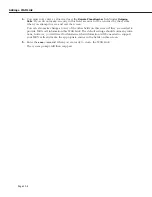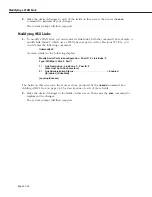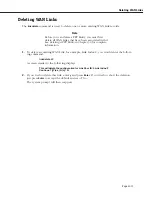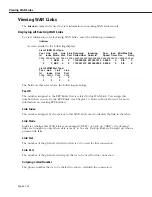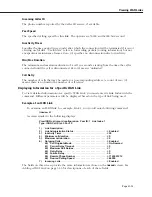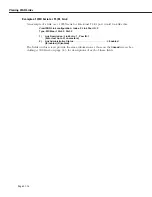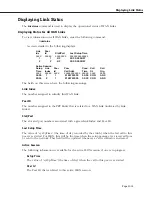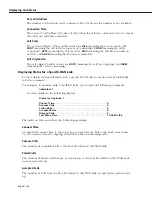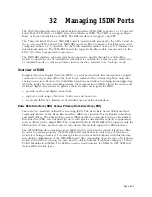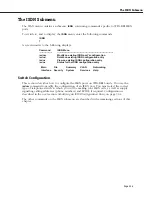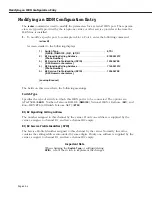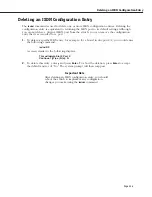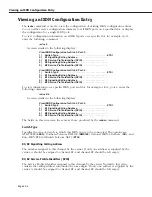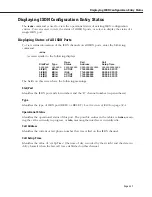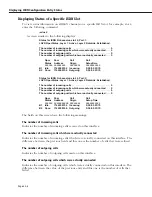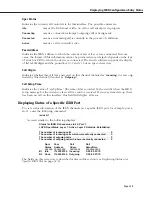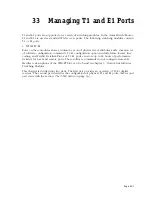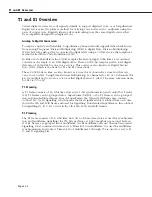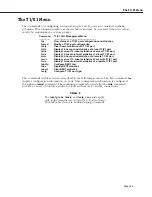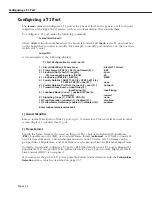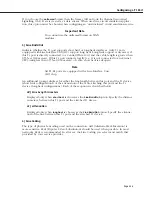
Page 32-2
“U”, “S/T” , and “R” Interfaces
The ISDN specification defines a limited set of user-to-network interfaces, including reference
points for the BRI access method. The following are the main BRI reference points:
U Interface.
The U interface is a two-wire (single pair) interface that supports full-duplex data
transfer from the phone switch. Only a single device can be connected to a U interface. This
device is called a Network Termination 1 (NT1) which converts the U interface to the S/T
interface (described below). The U interface is used in North America. Elsewhere in the
world, telephone companies supply the NT1 service, allowing customers the use of S/T inter-
faces.
S/T Interface.
The S/T interface is a four-wire, bus interface on which multiple (up to eight)
ISDN access devices can be attached to gain shared access to ISDN’s data channels. The S/T
interface is the most commonly-used interface in Europe.
R Interface.
The R interface is a general reference point at which non-ISDN devices can gain
access to an ISDN network through a device called a Terminal Adapter (TA). A Terminal
Adapter typically converts various standard interfaces, such as RS232 and V.35, to the S/T bus.
The “B,” “D,” and “H” Channels
ISDN supports three types of data channels: the “B” channel, the “D” channel and the “H”
channel. The line encoding and framing structure for each type of channel varies among the
U, S/T, and R interfaces and for different access methods. A brief description of the three
channels follows:
B Channel.
The B channel is used for the transfer of information, which can be any type of
data that the endpoints agree on, such as digitized voice, digitized video or packet data. The
B channel operates at 64 kbps on both BRI and PRI interfaces, but is commonly rate-adapted
to 56 kbps in North America to accommodate switching system limitations. A single BRI inter-
face consists of one D channel operating at 16 kbps and two B channels operating at 64 kbps
(or 56 kbps in North America).
D Channel.
The D channel operates at 16 kbps on BRI (64 kbps on PRI) and is used for carry-
ing common-channel signaling. The D channel is used both to establish and maintain circuit-
switched calls on the B channels. The D channel can also be used to carry low-speed packet-
switched data (the Omni Switch/Router does
not
support such usage).
H Channel.
The H channel, supported
only
on PRI interfaces, is used to transfer information at
higher bit rates by aggregating B channels. The four implementations of the H channel are:
H0 (384 kbps, 6 B channels), H10 (1472 kbps, 23 B channels), H11 (1536 kbps, 24 B chan-
nels), and H12 (1920 kbps, 30 B channels). The use of the H channel is
not
supported by the
Omni Switch/Router because this channel requires a PRI interface.
Summary of Contents for Omni Switch/Router
Page 1: ...Part No 060166 10 Rev C March 2005 Omni Switch Router User Manual Release 4 5 www alcatel com ...
Page 4: ...page iv ...
Page 110: ...WAN Modules Page 3 40 ...
Page 156: ...UI Table Filtering Using Search and Filter Commands Page 4 46 ...
Page 164: ...Using ZMODEM Page 5 8 ...
Page 186: ...Displaying and Setting the Swap State Page 6 22 ...
Page 202: ...Creating a New File System Page 7 16 ...
Page 270: ...Displaying Secure Access Entries in the MPM Log Page 10 14 ...
Page 430: ...OmniChannel Page 15 16 ...
Page 496: ...Configuring Source Route to Transparent Bridging Page 17 48 ...
Page 542: ...Dissimilar LAN Switching Capabilities Page 18 46 ...
Page 646: ...Application Example DHCP Policies Page 20 30 ...
Page 660: ...GMAP Page 21 14 ...
Page 710: ...Viewing the Virtual Interface of Multicast VLANs Page 23 16 ...
Page 722: ...Application Example 5 Page 24 12 ...
Page 788: ...Viewing UDP Relay Statistics Page 26 24 ...
Page 872: ...The WAN Port Software Menu Page 28 46 ...
Page 960: ...Deleting a PPP Entity Page 30 22 ...
Page 978: ...Displaying Link Status Page 31 18 ...
Page 988: ...Displaying ISDN Configuration Entry Status Page 32 10 ...
Page 1024: ...Backup Services Commands Page 34 14 ...
Page 1062: ...Diagnostic Test Cable Schematics Page 36 24 ...
Page 1072: ...Configuring a Switch with an MPX Page A 10 ...
Page 1086: ...Page B 14 ...
Page 1100: ...Page I 14 Index ...



